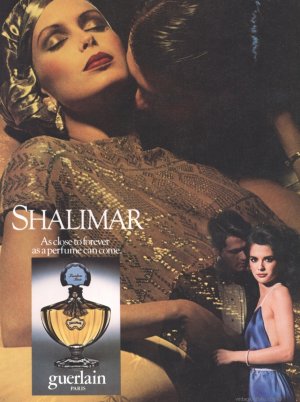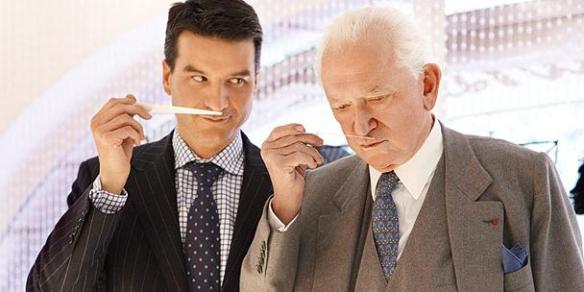I thought it might be nice to take a look at a very talented perfumer whom I deeply respect, but whose scents frequently seem to fly under the radar. It is a little surprising to me, given who she is. Patricia de Nicolaï of Parfums de Nicolaï comes from the Guerlain family, is a grand-daughter of the house’s founder, Pierre Guerlain, a niece of Jean-Jacques Guerlain, and a niece or cousin to the famed nose, Jean-Paul Guerlain. She is a pioneer amongst female perfumers, and has won prestigious honours from both her perfume peers and from the French government itself. Yet, even die-hard Guerlain lovers aren’t always intimately familiar with her works. I hope to remedy that in the upcoming weeks, but I thought I would first start with a look at the woman herself.
Patricia de Nicolaï fascinates me not only because she is a trail-blazer in some ways, but because she seems authentic, down-to-earth, passionate, warm, and wholly unpretentious. Though she has the Guerlain genes in more ways than just mere chromosomes, let’s start with Madame de Nicolaï’s genealogy. She is closely related to Jean-Paul Guerlain who is both the current family patriarch and the last Guerlain who creates fragrances for the house.(Several sites call her his niece, but Patricia de Nicolaï says her mother was his cousin, so wouldn’t that make her Jean-Paul Guerlain’s second cousin?) Jean-Paul Guerlain is legendary for his creations. According to Guerlain’s Wikipedia page, he made such legends as: Vétiver (1959); Habit Rouge (1965); Chant d’Arômes (1962), Chamade (1969), Nahéma (1979), Jardins de Bagatelle (1983), and Samsara (1989), along with Héritage and Coriolan in the 1990s.
Madame de Nicolaï grew up surrounded by the Guerlain culture. As her website explains, she “spent her childhood in the Guerlain family home in Paris. A home in which she has been in contact with 4 generations of Guerlain.” She elaborated a little further to the The Daily Mail newspaper:
I grew up surrounded by people who were fascinated by smell. My parents had a beautiful 18th century manor house in Burgundy with a lovely garden where the rooms were scented with Pot Pourri de Guerlain. Neither of my parents were noses but they had a vineyard and my mother was a famous wine taster. I think my love of fragrance was unconscious I grew up with it.
CaFleureBon has a superb, detailed interview with Madame de Nicolaï where her warmth, charm, and wit shine through in great abundance. I recommend reading in full if you’re interested, but I’ll quote my favorite part involving her memories of her childhood, her mother, and Shalimar. The quote not only creates the image of one, big family filled with strong characters who were all completely crazy about perfume, but also really underscores the powerful impact that one’s parents (and their fragrance) can have on a person’s olfactory development. As Madame de Nicolaï explained:
I lived within the Guerlain Parisian ‘Hôtel Particulier’ for the first 20 years of my life. We had – and we still have – a very big family and we all had our corner in this wonderful spot. I could tell loads of little stories about my childhood but if I had to take one moment, it would be when I was waken up every morning by the powerful and spellbinding Shalimar that my mother used to wear. I did not need an alarm clock in that time! The Shalimar scent was my morning wakeup call! And I loved it! My mother’s room was situated underneath mine and the scent came through my window which was always open, because sleeping with an opened window is in fact very healthy. You can trust my grandmother on that!
My mother loved Shalimar , it is true, but she really liked to be the first one to ‘test’ all the perfumes created by Jean-Paul Guerlain. She was the tender ‘guinea pig’ of her beloved cousin.
As an adult, Madame de Nicolaï attended the perfume school, ISIPCA, at Versailles, and then was employed at Quest, which later turned into Givaudan. During the late 1980s, she spent a few years working alongside some famous “noses,” like Maurice Roucel. There is also Sophia Grosjman whom she assisted on Lancome‘s very popular Tresor.
Madame de Nicolaï always forged her own path, in part because she was not allowed to work at the family business and, in part, because 30 years ago, perfumed doors were closed to women. In fact, there is an interesting article in the Edmonton Journal which talks about the glass ceiling faced by women perfumers:
When she graduated from ISIPCA, the perfumery school in Versailles, de Nicolai initially sought a job as a junior perfumer but doors were closed. “Because I was a woman. Even if the manager said yes, the chief perfumer didn’t ever want to have a woman on his team.”
She was never allowed to work at the family business. (To be fair, the family sold it to luxury goods behemoth LVMH in 1994, but still.)
“A lot of people ask me that,” de Nicolai shrugged, diplomatically, before adding: “You should ask that to the Guerlain family!” A couple years ago in Paris, when Jean-Paul Guerlain handed in the reigns of house master perfumer and LVMH brought in the first non-family member Thierry Wasseur, I had done just that. [¶]
Did he not believe that women could be good perfumers? I asked. Monsieur Guerlain, then 71, waved his hand dismissively and muttered something about de Nicolai being a woman who made scented salts and candles.
To put it as politely as I can, Jean-Paul Guerlain seems to have … er… issues… with a number of social groups, beyond just women, as evidenced by his attitude towards minorities and immigrants. I am doing my utmost to refrain from commenting further.
Still, Madame de Nicolaï had talent that other people couldn’t deny or so easily dismiss. In fact, she seems to have had the last laugh. In 1988, she became the very first woman to ever win the “Prix International du Meilleur Parfumeur“, an award given to the best international perfumer from the French Society of Perfumers (SFP). According to Madame de Nicolaï’s Wikipedia entry, Luca Turin reportedly called her “…one of the unsung greats of the fragrance world.”
In 1989, Madame de Nicolaï founded her own company, alongside her husband, Jean-Louis Michau. I suspect she did so in part because there were not a lot of other options open to her. As she stated in the CaFleureBon interview, her uncle (Jean-Paul Guerlain presumably) had told her that she had “to improve [her] skills and then ‘we’ll see’. This ‘we’ll see’ never happened.”
The Parfums de Nicolai website merely states that she
started ‘NICOLAI, parfumeur-créateur’ … to continue the prestigious family tradition of perfume creation. The concept was to emphasise the role of the perfumer. A perfumer free in his creative choices and free to use the best quality ingredients available.
With an impressive number of creations, Patricia de Nicolai has succeeded in building one of the largest collections of fragrances in the contemporary perfume business.
She is in charge of the creation of the fragrances as well as the purchase of the raw materials and the making of the concentrates.
In all these creations her personal style appears, giving a real signature imprint. Patricia de Nicolaï’s creations are identifiable, original and elegant reflecting the high Parisian ‘parfumerie’ and ‘Le luxe à la française.’ […][¶]
She is also the only independent woman perfumer to have her own fragrance company. [Emphasis in the original, not from me.]
In 2002, Jean-Paul Guerlain retired from the family business as Guerlain’s official nose. Many assumed the mantle would pass to Patricia de Nicolaï. Well, apparently, that glass ceiling is alive and well at Guerlain, even under LVMH ownership. Madame de Nicolaï was passed over entirely for the role of in-house perfumer, a position that eventually went to Thierry Wasser in 2008.
I find it utterly astonishing that a talented, much admired and respected nose who is an actual member of the Guerlain family was brushed aside. I simply can’t wrap my head around it. Guerlain’s Wikipedia page states: “With no heir from within the Guerlain family to take over, the role of master perfumer is no longer tied to family succession.” But there was an heir! An heir who was an actual nose, and who had received international recognition from her peers at an extremely young age! A 100+year family tradition was broken simply because Madame de Nicolaï was a woman??! It’s bloody outrageous.
Today, Patricia de Nicolaï runs her personal company, but is also the president of L’Osmothèque, the famed perfume museum at Versailles. It has become the main guardian of what is left of many of the legendary perfumes of the past, perfumes from Houbigant, Coty, and the like, perfumes that have now vanished from existence except for the tiny quantities that Osmothèque keeps in a Fort Knox-like vault. (You can read all about the fascinating place in a Fragrantica article, if you’re interested.) Osmothèque’s importance is just one of the reasons why France awarded Madame de Nicolaï its greatest honour when it made her a Chevalier de la Légion d’Honneur in 2008.
Madame de Nicolaï is passionate about the cultural importance of perfumery. As the Edmonton Journal article makes clear, she believes perfume
it is part of the French cultural heritage, as important a cultural and economic export as fashion (which, in the aftermath of the Second World War, saved the country’s economy thanks almost entirely to Christian Dior’s New Look). “It’s a notion of art, and when in the middle of the 19th century synthetic molecules appeared and perfumers were not only chemists or apothecaries, they became really creators,” de Nicolai said.
“Perfume is probably the most sophisticated creation to make,” she added; “it’s very intellectual. It’s the most valuable product of our spirit.” More important than gender, she said, is that each creator has what in fine art is called la patte d’un peintre — the hand of the artist. “You recognize Beethoven, Mozart immediately,” de Nicolai said, and so too the signature of a perfumer.
Her own olfactory signature admits to certain genetic tendencies. “I am influenced by my family!” she admitted with rueful laugh. “Growing up Guerlain was always only nice perfumes, something you could recognize from afar, the sillage, and you would know it was Guerlain. I wanted to have the same approach.”
I respect Madame de Nicolaï for her character more than for anything to do with Guerlain. It’s not only her passionate commitment to the art of perfumery, but what seems to be to be something that I can only describe as integrity. She puts her head down, and quietly creates what she thinks is beautiful. Fads or popular trends be damned; it’s beauty and elegance which matter.
In fact, as she told CaFleureBon, one reason why she left Quest (Givaudan) was because she was fed up “by the practice of creating fragrances based on focus groups and marketing questions. I was very frustrated and I wanted to be free!” Her desire to be true to her own beliefs helps explain why it has taken Madame de Nicolaï years to put out a fragrance with oud. She did so finally in late 2013, only after intensely studing the character of the wood. As she said in her CaFleureBon interview, “I did not want to be trapped by trends. I am a free woman, free to create my own perfumes the moment I want to, regardless of any marketing concepts.”
I can’t tell you how much I respect all that. I’m a sucker for quiet intellectuals who also seem to be very down-to-earth, funny, humble, self-deprecating, warm and kind — traits which all the interviews demonstrate that Madame de Nicolaï has in abundance. Really, CaFleureBon did a stupendous job with their interview, and it is a stellar read from start to finish. It’s also quite funny in parts. I laughed like mad at Madame de Nicolai’s confession that she would have loved to make a perfume for Margaret Thatcher… because of how challenging it would be.
Apart from the three interviews linked up above, The Smelly Vagabond also has an account of an evening which a London perfume group spent with Madame de Nicolaï last year. It has lovely personal anecdotes, like how Madame de Nicolaï’s daughter suddenly “gets the flu” whenever she’s required to smell perfume. Or the key role played by her very supportive husband who urged her to begin her own perfume house:
At that time I had to take care of my children. My husband told me that if I stopped working in the perfume industry I would never be able to come back to it. Working for other companies was not an option because there is not enough freedom for the perfumer, who is under the whims of the marketing team. There is competition not just within the company but outside as well. So my husband told me that if I made the perfumes, he would settle the rest of the business.
As for her perfumes, well, there is one that I instantly liked, and liked so much that its memory stayed with me for months after I tried it in Paris and I ended up buying it. That will be the subject of the next review. The rest of her line isn’t always very “me,” however, as I find that many lack the sort of bold, opulent heaviness that I enjoy. However, I respect them a lot, appreciate their very classique feel, and can see the technical skill behind them.
I get the sense that there often seems to be one single Nicolai perfume that wrap its tentacles around you and becomes “yours.” Take, for example, Luca Turin who loved Madame de Nicolaï’s New York cologne so much that he wore it for a whole decade. In Perfumes: the A-Z Guide, he gives New York his highest 5-Star rating, and writes :
If Guerlain had any sense they would buy Parfums de Nicolaï, add her range to theirs, trash fifteen or so of their own laggard fragrances, a couple of de Nicolaï’s, and install owner-creator Patricia in Orphin as in-house perfumer. She is, after all, a granddaughter of Pierre Guerlain and genetic analysis might usefully reveal the genes associated with her perfumery talent. As a control where the genes are known to be absent, use the DNA of whoever did Creed’s Love in White. Smelling New York as I write this, eighteen years after its release, is like meeting an old high-school teacher that had a decisive influence on my life: I may have moved on, but everything it taught me is still there, still precious, and wonderful to revisit. New York’s exquisite balance between resinous orange, powdery vanilla and salubrious woods shimmers from moment to moment, always comfortable but never slack, always present but never loud. It is one of the greatest masculines ever, and probably the one I would save if the house burned down. Reader, I wore it for a decade.
I have samples of a few Nicolaï scents to test in the upcoming weeks or months, including Luca Turin’s beloved New York. It’s a nice, masculine fragrance which contains some of the Guerlain DNA, as it opens with a very superficial similarity to Habit Rouge before turning into something very different and wholly chypre-like in nature. I also have the oriental Maharanih (which I may skip reviewing as it has been discontinued in favour of the new Intense version), and the new Amber Oud whose notes include everything from lavender and thyme, to cinnamon, saffron, cedar, styrax, musk, castoreum and amber.
First up, though, will be the scent which I fell for and bought for myself, Sacrebleu Intense, a fragrance which I find to be a darker, non-powdery and possibly more unisex, modern take on Guerlain’s legendary masterpiece, L’Heure Bleue.
The Guerlain DNA, indeed. Better still, it’s from a really lovely person.












